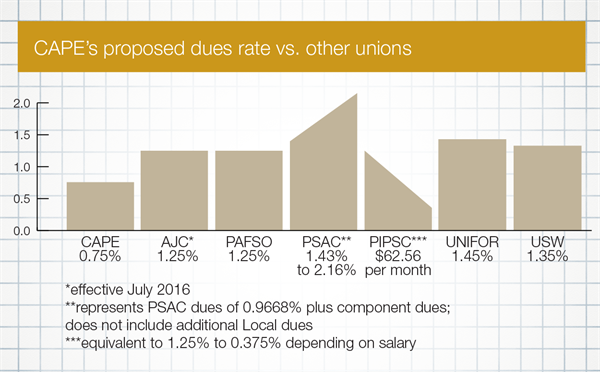Where can I get more information about this?
The best place to start is our updated webpage on the topic. You can also get more information on the process by checking out our original overview of the options. It comes with detailed graphs and real-life applications for dues structure being proposed.
How did this come about? Why now?
Last November, our membership voted in favour of a resolution, drafted by two members of our Young Members Advisory Committee, asking CAPE to examine options for a progressive dues structure. The information you’ve been provided is the product of that work.
The three options were discussed and debated during a special general meeting as well as in local annual general meetings across the country from February through May. These discussions and straw polls helped steer the National Executive Committee in choosing a single option – option 3, a flat rate of 75% across the board – for the members to vote on.
On June 15, members will receive an electronic ballot containing three budget-related questions. For the one pertaining to the progressive dues structure, members will be presented with two options: to adopt the proposed progressive dues structure or stick with the status quo.
Isn’t this just a hidden dues increase?
Some members would see their dues increase while others would see theirs decrease. The aim is to make the system fairer for everyone as a proportion of income. This proposal is simply a revenue-neutral change in our dues structure at the point in time when it is established. Because it isn’t possible to make it exactly revenue-neutral to the dollar, there is a small projected increase in revenue equivalent to $44,515 or a 0.567% increase.
Over time, however, as CAPE successfully negotiates salary increases for its members, its revenue would increase accordingly. So, there is a clear benefit for our association; our operations would become more sustainable, since our revenue would slowly increase over time alongside inflation. It’s worth noting that CAPE’s expenditures also increase over time (staff salary increases, inflation, etc.). That said, CAPE holds annual membership budget meetings where members are invited to review and approve the budget each year. Just because the organization’s operations become more sustainable doesn’t mean members won’t be asked for their input on the budget each year.
Why should I pay more just because I make more money? We all get the same services.
There are a few ways to look at this question. For starters, when CAPE negotiates salary increases for its members, these are proportional to income. A 1.5% increase for someone earning $50,000 a year represents $750; someone earning $100,000/year will get an extra $1,500 out of that increase.
Yet, at the moment, both individuals pay $48 a month in dues.
And that $48 does represent a higher burden for those on the lower-end of the salary scale.
Yes, we all pay the same for a carton of milk regardless of how much we earn. On the other hand, we all pay income tax as a proportion of our income, as part of a system that is made up of various tax rates and tax brackets. Canada’s progressive income tax system – which ensures that everyone pays their fair share, not an equal share – helps alleviate some of the burden that inevitably falls on lower-income earners.
The problem with CAPE’s current flat-fee dues structure is that it’s a lot like a regressive tax; the share of dues paid decreases as income rises. An employee who earns $50,000 invariably ends up spending a significant proportion of their income on goods and services, while someone who earns a higher income would tend to have more funds left over to save and invest.
We’re a union; our role is to promote a better quality of life for all workers. Our role is to promote fairness and equal opportunity. It’s therefore incumbent on us to ensure that our dues structure is consistent with those same principles and values.
So, should CAPE continue to be part of a system that imposes a higher burden on employees at the lower-end of the pay scale?
We believe there’s a better and fairer way.
How does compare with my colleagues from different unions?
Many other unions in the federal public service already have progressive dues structures, but at higher rates than what we’re proposing. In the overview, we compared dues across unions with the following graph:
But, it’s worth turning those numbers into real-life examples. Here are other interesting real-life examples of dues paid across the PS:
How do I make my voice heard?
The February 25 meeting kick-started a series of debates and discussions, which we held in workplaces across the country from February through May; the sum of that feedback helped the National Executive Committee select a single option to vote on.
The June 8 membership budget meeting will allow members to express their views, either in person or via webcasting. During the meeting, we’ll be recording video, which later be uploaded to YouTube. This will allow members who couldn’t attend the meeting to hear all the perspectives in order to cast an informed vote.
On June 15, members will receive an electronic ballot containing three budget-related questions. For the one pertaining to the progressive dues structure, members will be presented with two options: to adopt the proposed progressive dues structure or stick with the status quo.
Who decides?
You do. There has been a lengthy consultative process in the lead-up to the June vote. Members were first asked, via a resolution, if they wanted CAPE to explore options for a progressive dues structure. That resolution passed by an 18-point margin.
Next, members were invited to discuss and debate the options during a February special general meeting. Similar debates were held in workplaces across the country, from February through May. Straw polls held at these meetings helped the National Executive Committee select the most popular option among the three presented: option 3 – a flat rate of 75% across the board.
At the June 8 membership budget meeting, members will once again have the opportunity to discuss and debate the pros and cons of adopting a progressive dues structure. The entire membership will once again be invited to vote on a resolution, which will present two options: vote in favour of the progressive dues structure or stick with the status quo.
How many options will be presented to the membership for a vote?
The membership will only vote on one option. Members will be asked to either adopt the resolution, which would establish the progressive dues structure, or reject the resolution, thereby maintaining the status quo.
I prefer the status quo; how do I vote for that?
On June 15, you will be asked to vote on the implementation of a progressive dues structure; a “no” vote will be a vote to maintain the status quo.
How do I cast my vote?
Keep an eye on your inbox for a ballot on June 15. Speaking of which… is your contact information up to date? You can update it by clicking here.
If adopted, when would the progressive dues structure kick-in?
The progressive dues structure would take effect in November 2016.
I have another question that isn’t answered here.
Please contact us by email; we’ll be happy to look into it!





